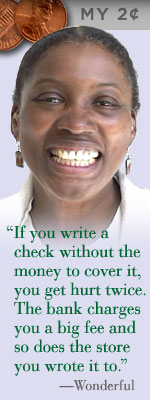How checking accounts work
Deposits:
- You deposit money into your account. You can do that by visiting a bank or using an ATM.
- If you get regular checks from work or Social Security, you can arrange to have that check sent directly to your account. That is called “direct deposit.” Your check is sent right to your account. It’s free and saves you time.
Withdrawals:
- You take money out by writing checks or by getting cash from the ATM. You can also use a “debit card” to make payments at stores and gas stations. Some people like to have the bank pay their bills for them (called “automatic deduction”).
- The bank keeps track every day of how much money is left in your account (your “balance”). You need to make sure the money is there before you try to spend it. You can keep track using a check register.
- If you try to write a check for more money than there is in your account, that check will “bounce” which means it is sent back to you without being paid. Your bank will charge you for having ”insufficient funds” unless you have signed up for “overdraft protection.”
Statements:
- Each month your bank will send you a list of the activity (deposits and withdrawals) that you have made.
You can use your statement to keep track of what you are spending your money on for your monthly saving and spending plan. Click here to see a sample statement.
Back to Bank Accounts |

